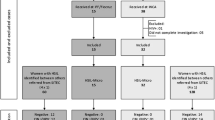Abstract
Objective
To evaluate the preceding cervical cytology and factors leading to cytohistologic discrepancy in women with high-grade squamous intraepithelial lesion (HSIL) histology.
Methods
The records of women who were found to have histologically confirmed HSIL without any associated invasive and glandular lesions, at Chiang Mai University Hospital between January 2005 and May 2009, were reviewed. Cytohistological discrepancy was defined as HSIL histology preceded by low-grade squamous intraepithelial lesion (LSIL) and atypical squamous cells of undetermined significance (ASC-US) smears.
Results
The records of 436 HSIL cases were reviewed. The mean age of the women was 45.0 ± 9.3 years. The preceding smear abnormalities were as follows: 275 (63.1%) with HSIL; 50 (11.5%) with atypical squamous cells cannot exclude high-grade squamous intraepithelial lesion (ASC-H); 40 (9.2%) with squamous cell carcinoma; 35 (8.0%) with LSIL; 32 (7.3%) with ASC-US; and 4 (0.9) with glandular abnormality smears. Overall, the rate of cytohistological discrepancy was 15.4% (95% CI 12.1–19.1%). The small size of HSIL and presence of coexisting LSIL are significant independent predictors for cytohistologic discrepancy.
Conclusion
Approximately 15% of HSIL cases are under-diagnosed by cytology. Significant factors leading to cytohistologic discrepancy are lesion size and the presence of coexisting LSIL.
Similar content being viewed by others
References
Kesic V (2009) Cervical preinvasive disease. In: Ayhan A, Gultekin M, Dursun P (eds) Textbook of gynaecological oncology. Gunes Publishing, Ankara, pp 15–20
Barton SE, Jenkins D, Hollingworth A, Cuzick J, Singer A (1989) An explanation for the problem of false-negative cervical smears. Br J Obstet Gynaecol 96(4):482–485
Gupta S, Sodhani P (2004) Why is high grade squamous intraepithelial neoplasia under-diagnosed on cytology in a quarter of cases? Analysis of smear characteristics in discrepant cases. Indian J Cancer 41(3):104–108
Lyall H, Duncan ID (1995) Inaccuracy of cytologic diagnosis in high grade squamous intraepithelial lesions (CIN 3). Acta Cytol 39(1):50–54
Massad LS, Behbakht K, Collins YC, Cejtin HE (2003) Histologic findings from the cervix among older women with abnormal cervical cytology. Gynecol Oncol 88(3):340–344
Tidbury P, Singer A, Jenkins D (1992) CIN 3: the role of lesion size in invasion. Br J Obstet Gynaecol 99(7):583–586
Zuna RE, Sienko A, Lightfoot S, Gaiser M (2002) Cervical smear interpretations in women with a histologic diagnosis of severe dysplasia: factors associated with discrepant interpretations. Cancer 96(4):218–224
Jarmulowicz MR, Jenkins D, Barton SE, Goodall AL, Hollingworth A, Singer A (1989) Cytological status and lesion size: a further dimension in cervical intraepithelial neoplasia. Br J Obstet Gynaecol 96(9):1061–1066
Howell S, Theodor M, Pacey NF, Patwardhan JR, Ayer B (1997) Quality assurance in cytology. Rescreening of previously negative smears from high grade squamous intraepithelial lesions. Acta Cytol 41(4):1085–1090
Alli PM, Ali SZ (2003) Atypical squamous cells of undetermined significance—rule out high-grade squamous intraepithelial lesion: cytopathologic characteristics and clinical correlates. Diagn Cytopathol 28(6):308–312
Barreth D, Schepansky A, Capstick V, Johnson G, Steed H, Faught W (2006) Atypical squamous cells-cannot exclude high-grade squamous intraepithelial lesion (ASC-H): a result not to be ignored. J Obstet Gynaecol Can 28(12):1095–1098
Kietpeerakool C, Srisomboon J, Tantipalakorn C, Suprasert P, Khunamornpong S, Nimmanhaeminda K et al (2008) Underlying pathology of women with “atypical squamous cells, cannot exclude high-grade squamous intraepithelial lesion” smears, in a region with a high incidence of cervical cancer. J Obstet Gynaecol Res 34(2):204–209
Liman AK, Giampoli EJ, Bonfiglio TA (2005) Should women with atypical squamous cells, cannot exclude high-grade squamous intraepithelial lesion, receive reflex human papillomavirus-DNA testing? Cancer 105(6):457–460
McHale MT, Souther J, Elkas JC, Monk BJ, Harrison TA (2007) Is atypical squamous cells that cannot exclude high-grade squamous intraepithelial lesion clinically significant? J Low Genit Tract Dis 11(2):86–89
Saad RS, Dabbs DJ, Kordunsky L, Kanbour-Shakir A, Silverman JF, Liu Y et al (2006) Clinical significance of cytologic diagnosis of atypical squamous cells, cannot exclude high grade, in perimenopausal and postmenopausal women. Am J Clin Pathol 126(3):381–388
Conflict of interest statement
None.
Author information
Authors and Affiliations
Corresponding author
Rights and permissions
About this article
Cite this article
Songveeratham, S., Kietpeerakool, C., Khunamornpong, S. et al. Preceding cervical cytology in women with high-grade squamous intraepithelial lesion. Arch Gynecol Obstet 283, 1381–1384 (2011). https://doi.org/10.1007/s00404-010-1581-3
Received:
Accepted:
Published:
Issue Date:
DOI: https://doi.org/10.1007/s00404-010-1581-3




